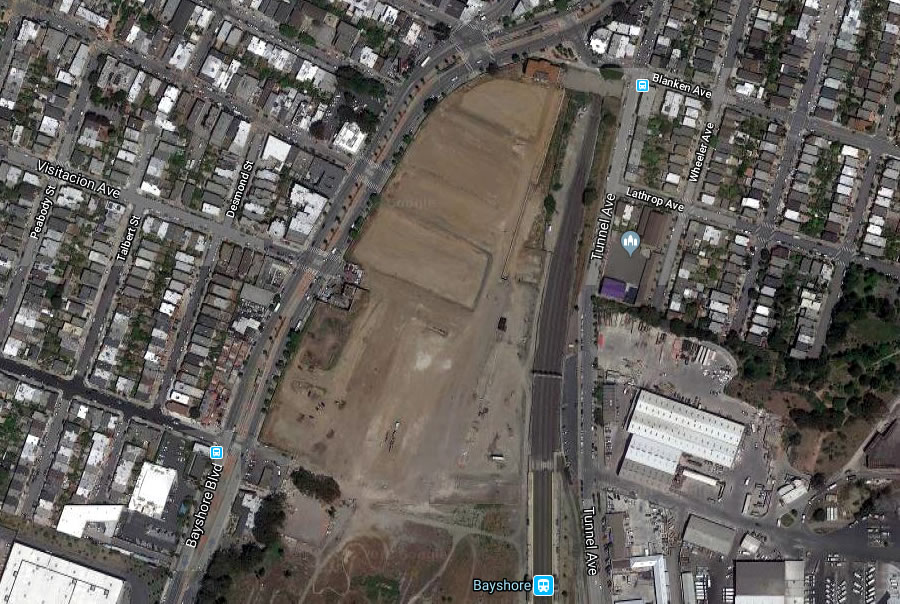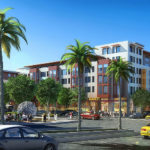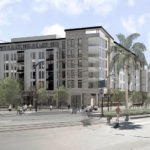Shuttered back in 1999, the old Schlage Lock factory and Southern Pacific Railyard parcel along Bayshore Boulevard, near the heart of Visitacion Valley, was leveled 10 years later in order to clear the way for a proposed 20-acre transit village to rise.
As approved back in 2014, at which point it was expected to break ground the next year, the development is slated to include nearly 1,700 units of housing, up to 47,000 square feet of new retail and restaurant space (including a new full-service grocery), two new public parks, parking for nearly 1,200 cars and the rehabilitation of the historic Schlage office building which was left standing at the corner Bayshore and Blanken.
And while some rough grading and site work has since been conducted, the construction of any new buildings has yet to get underway.
But according to an update from the Visitation Development team, they’re now planning to secure building permits for the first phase of the project, which includes 574 units of housing and the grocery store site, as well as the future Leland Park, across Blocks 1-6 on the northern portion of the site.
If all goes as currently planned, the first phase of construction will be completed by the end of 2021.
But the redevelopment of the aforementioned historic office building is looking like it will likely be pushed to the second phase of the project, as could the construction of a pedestrian way from Bayshore Boulevard to the adjacent Bayshore Caltrain station.
We’ll keep you posted and plugged-in.




So why the delay since 2015?
$$$$$
Better than nothing, but as usual with SF, reeks of mediocrity. A measly 1700 units at the terminus of the T and along the 8, 9 and 9R lines that run all the way downtown. No reason this shouldn’t be upzoned a bit, by I understand why some wouldn’t want to obstruct views of the hellscape that is the hood around Bayshore+Geneva.
This should be 17,000 units. What is wrong with this city?
High-rise in this location probably prohibited by soil conditions.
Geneva Towers.
Implosion and History of Geneva Towers Housing Projects (circa 1998)
While I wouldn’t mind seeing a taller development here, if I may, I’d like to suggest more impactful opportunities to increase housing:
1. We need small to medium projects that add units in established neighborhoods, whether it’s the single-family zones in Little Hollywood east of this site and in Visitacion Valley west of this site; or the single-family and duplex zones all around Glen Park BART and West Portal station; or the pockets of the Mission still zoned RH-2 and RH-3, like this lot featured on SocketSite yesterday. In addition to zoning changes, we need streamlining and to do away with discretionary review so smaller “missing middle” projects aren’t held up by red tape.
Smaller projects help avoid putting all our housing eggs in a few baskets; Mission Rock, the Shipyard and this project together make a sizable chunk of our housing pipeline and all are delayed or stalled.
2. If you do want to focus on a large single development, the Balboa Reservoir project is not yet finalized. The current plan is for 1200 homes, a lower density than Schlage Lock. Supervisor Cohen asked the city to study a 5,000 unit option in the EIR so we have flexibility to increase it in a few years, but the city seems to be ignoring her request, and meanwhile Westwood Park NIMBYs are trying to downsize even the 1200 unit figure to half that.
I see the comments complaining about the lack of units for the site, but what i don’t see going along with that is a true understanding of what a ten fold or significant increase in design units means.
If you have ever, ever, ever attempted to get to 280/101 traveling Northeast on Bayshore then you would think twice about such a increase in density unless you have a transportation model to accommodate such density. Tunnel Ave is only two lanes and only makes for a southbound 101 entrance unless you follow it all the way to Sierra Point and Blanken Ave. through Little Hollywood is not much better and will only be more congested with any development to Executive Pkwy. To have such a dense development would require significant adaptation/creation of freeway access, improved public transportation, and/or larger boulevards which Visitacion Valley cannot accommodate as the streets of Visitacion Valley are notoriously narrow (see Leland Ave.).
Much more than 1,700 units I am almost certain means significant traffic issues but also likely creates a wealth of other infrastructure concerns that a developer would have to consider and bear responsibility for. The City of San Francisco only has two wastewater treatment facilities to handle all wastewater flow. For such a development developers are responsible for building in the infrastructure and should projected discharges overwhelm existing infrastructure they would be responsible for building/upgrading/partnering with City to manage those flows. 17,000 units of housing is a significant contribution and would likely be cost prohibitive if it meant a developer spending significant funds to achieve this along with the delays for such design and review.
At a certain point the demand for density has to be paired against real life challenges and that includes far more than bike and vehicle parking but also access for those who cannot assume Uber/Lyft as primary transportation options, and it also includes being aware of the demands that density puts on fundamental infrastructure. Cities such as NYC would be crippled if not for its massive subway system one which San Francisco cannot compare, and it is their subway system not the use of cars/bikes alone that made many of their developments at all possible/plausible.
The T Line doesn’t work if you live in Visitacion Valley and need to go downtown in a timely manner. Caltrain might be a option when/if it ever goes to the new Transbay Terminal…
thank you for injecting some sanity into the discussion
Will the residents in this area be able to easily cross the tracks to access the Northbound entrace to 101 (Harney Way)?
As a local of this neighborhood, I get onto the 280/101 every day and it is not nearly as big an issue as stated above. Like every other part of SF, it gets busy at peak hours, but it is not a big pain otherwise.
What is missed here is that the Schlage Lock, Executive Park and even Candlestick Point developments will bring large transportation investments to this long forgotten part of SF. Caltrain will expand it’s services at Bayshore station once the tracks get electrified and once more dense housing gets built in Visitacion Valley (and hopefully at adjacent Bayshore Baylands).
Further, some lament increasing pressure on existing infrastructure such as wastewater treatment facilities. In fact, the wastewater facility in the Bayview is being upgraded and the city is working on improving traffic flows by extending Geneva avenue to loop across 101.
As of today, Visitaction Valley is a backwater of SF, squeezed between highways, old industrial areas and a poorly designed street grid. These developments will make it a much more accessible and desirable place to live. If there is any part of SF that needs these types of denser developments, then it’s Viz Valley.
[Editor’s Note: As we previously reported, the Planning for a Southern Neighborhoods Transit Hub [is] Underway.]
The wastewater facility in the Bayview is the final treatment facility before discharge to the bay…that speaks nothing to how flows get to that facility. Many of these developments require larger sewers, storage facilities, and bypasses, not to mention a combined sewer system with a push to divide sanitary and stormwater contributions.
As for getting onto 280/101..you say it is not a big pain, but are you imagining when the density of residents and new visitors begin to use the area, specifically those coming from the Geneva corridor. As a lifelong SF resident i’ve seen how quickly 3rd street has come to a halt with only the dogpatch/mission bay development, and that does not even speak to the future of Pier 70. Simply put this development still requires significant transit planning and expansion of infrastructure and traffic on the part of Caltrain, Caltrans, SFMTA are always in the reactive and not the proactive.
Regarding sewers, stormwarter and similar infrastructure, the application document for phase 1 of the Schlage Lock development contains plans on how these services will be expanded and provided for the new residents. It was reviewed and approved by the city’s department who deals with these matters, so I don’t expect it to be a major issue. Remember, the new residents will also pay taxes in SF, so the means to build out the infrastructure should not be an issue.
As socketsite added to my notes, there is a longstanding plan on how to improve transportation links in this area. Of course, if 10’000 new residents were added to the area without any public transit investments, then infrastructure would be overwhelmed. However, this is clearly not the case. There is large potential for improving transit links in this area (better access to Caltrain, better access to BART via Geneva street and even better access to the northbound 101 ramp via the extension of Geneva-Harney streets across the 101).
The 8 bus, between here and Balboa Park station, could also be greatly improved where it runs along Geneva Ave. Better stop spacing, far-side versus near-side stops, green light extenders, and red bus lanes would make a huge difference. Basically the same treatment the 14/49 got on Mission Street.
Problem is, the current District 11 Supervisor worships the car, so it would take a lot of advocacy to get red lanes.
Don’t forget the Martin Building Company owned parcel along the east side of the site. An unresolved easement issue related to their property is directly responsible for not including the pedestrian path from Bayshore Blvd to the Caltrain station in this first phase.
Later phases of development will be significantly affected if the two property owners don’t resolve this issue going forward.
The map shows that property as public open space, so perhaps it was acquired by the developer?
While shown as open space on the site plan above, the sliver of a parcel remains in the hands of Martin Building Company and neither an outright sale nor easement has been obtained by the Visitacion Development team. At the same time, the plans for the parcel have not progressed beyond the preliminary planning (and potential thorn in the side) stage.
To note here, it will take 22 years to build 1700 units of housing (1999 to 2021). There are two major rail stops here (Caltrain, Muni) yet low density is being constructed.
The site is surrounded by low density (by SF standards) housing. This site is not low density.
This plan is objectively not low density.
1700 units on 20 acres is 85 DUs/acre. That’s not high rise density but it is far from “low density”. Also being at the *end* of the T, 8, and 9 doesn’t really argue for massive density. Upzone closer in spots instead. Finally, the Bayshore Caltrain station is unfortunately unlikely to ever see frequent service because of how Caltrain uses the tracks in that area as a bypass for bullets.
The city should make construction of the pedestrian connection to Bayshore Caltrain a condition of phase 1. There’s no reason other than minor financial benefits to the developer to push that POC unto phase 2. It would be useful today even with this site vacant.
The target should be for working class neighborhood where people commute to downtown via public transportation.
It was a pretty contaminated site. Is the clean up of all the toxic waste is done? Did someone independent check it so we don’t end up with another Hunters Point?
What about the HSR / Caltrain yard options being entertained? If these get approved, then our tax dollars will get wasted on Eminent Domain fees.
UPDATE: New New Timing for Major Visitacion Valley Redevelopment